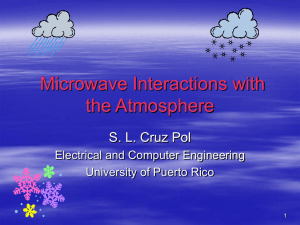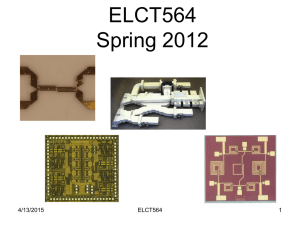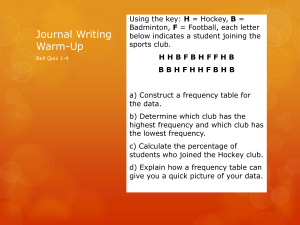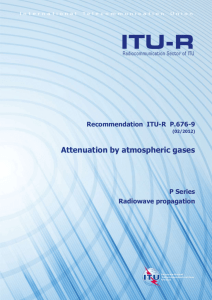Word - ITU
advertisement
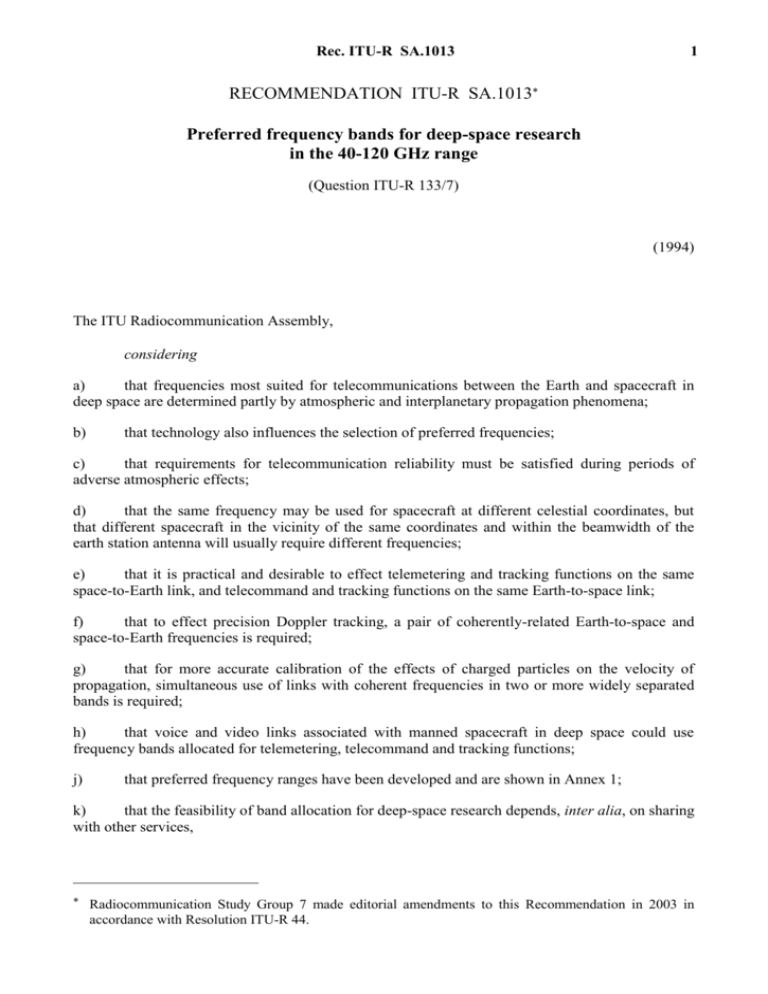
Rec. ITU-R SA.1013 1 RECOMMENDATION ITU-R SA.1013* Preferred frequency bands for deep-space research in the 40-120 GHz range (Question ITU-R 133/7) (1994) The ITU Radiocommunication Assembly, considering a) that frequencies most suited for telecommunications between the Earth and spacecraft in deep space are determined partly by atmospheric and interplanetary propagation phenomena; b) that technology also influences the selection of preferred frequencies; c) that requirements for telecommunication reliability must be satisfied during periods of adverse atmospheric effects; d) that the same frequency may be used for spacecraft at different celestial coordinates, but that different spacecraft in the vicinity of the same coordinates and within the beamwidth of the earth station antenna will usually require different frequencies; e) that it is practical and desirable to effect telemetering and tracking functions on the same space-to-Earth link, and telecommand and tracking functions on the same Earth-to-space link; f) that to effect precision Doppler tracking, a pair of coherently-related Earth-to-space and space-to-Earth frequencies is required; g) that for more accurate calibration of the effects of charged particles on the velocity of propagation, simultaneous use of links with coherent frequencies in two or more widely separated bands is required; h) that voice and video links associated with manned spacecraft in deep space could use frequency bands allocated for telemetering, telecommand and tracking functions; j) that preferred frequency ranges have been developed and are shown in Annex 1; k) that the feasibility of band allocation for deep-space research depends, inter alia, on sharing with other services, * Radiocommunication Study Group 7 made editorial amendments to this Recommendation in 2003 in accordance with Resolution ITU-R 44. 2 Rec. ITU-R SA.1013 recommends 1 that between 40 and 120 GHz, band allocations for deep-space research be selected from the preferred frequency ranges given in Table 1; 2 that the bandwidth requirements of Recommendation ITU-R SA.1015 be taken into account; 3 that the feasibility of sharing with other services be considered (see Recommendation ITU-R SA.1016). Annex 1 Selection of frequency bands in the 40-120 GHz range that are preferred for deep-space research 1 Introduction The performance of links between earth stations and stations in deep space is affected by the atmosphere of the Earth. Attenuation and emission by the atmosphere generally limits deep-space telecommunications. There are, however, certain frequency bands where atmospheric attenuation is low enough to permit links between earth stations and deep-space stations. Additionally, there are certain bands that would be particularly suitable for links between an earth-orbiting relay station and deep-space stations. This Annex considers the selection of preferred frequency bands for deep-space telecommunications in the 40-120 GHz range. The selection of bands in the range 1-40 GHz, that are preferred for deep-space research, is given in Recommendation ITU-R SA.1012. 1.1 Advantages of higher frequencies Radio frequencies above 40 GHz can provide advantages for deep-space telecommunications. The advantages are higher link performance, potential for wider bandwidth, reduced errors in measurements that depend on the velocity of propagation, and the possibility of shielding from terrestrial interference. 1.1.1 Increased link performance For a fixed transmitter power, the power received via a free-space link between perfect antennas with fixed apertures varies in direct proportion to the frequency squared. A practical example of this circumstance is the case of a path between a spacecraft in deep space and a relay satellite in orbit above the atmosphere of the Earth. If technology does not limit the choice of frequency in a particular range that is being considered, the highest frequency in that range will provide the best link performance. Rec. ITU-R SA.1013 3 For transmission through the atmosphere, there are certain bands above 40 GHz where the atmospheric attenuation is low enough to allow practical communication. The increased performance of higher frequency links may be utilized for command, telemetering and radiometric functions. Alternatively, the higher performance may be traded for smaller and lighter spacecraft antennas and transmitters. 1.1.2 More accurate measurement of phase and group-delay Accurate navigation of deep-space probes depends, in part, upon determination of their position and velocity by means of phase and group-delay measurements of received signals. These measurements are influenced by the velocity of propagation along the transmission path. The velocity of propagation is a function of the density of charged particles along the path. The effect of these particles varies inversely with the square of the frequency and, hence, higher frequencies are preferable for purposes of navigation and certain other radio measurements. 1.1.3 Shielding from terrestrial interference It may be desirable to employ a geostationary relay station for signals to and from deep-space probes. The links between such a station and deep-space probes would be free of the perturbing effects of the atmosphere. These links could also be protected from terrestrial interference by choosing frequencies where the atmosphere is relatively opaque to radio signals. There are such frequencies in the 40-120 GHz range. 1.1.4 At higher frequencies, it is usually possible to provide wider band allocations. Such allocations can accommodate wider transmission bandwidths. The wider bandwidth permits use of more complex coding schemes which provide reduced data error rates and reduced susceptibility to interference. 1.2 Basis for frequency selection Selection of preferred frequencies is based on link performance as affected by propagation and equipment characteristics. In the next three sections of this Annex, we examine the factors that influence frequency selection. Some of these factors provide the information needed to calculate an index of link performance. This index may be expressed as Pr /N0, the ratio of total received power to noise power spectral, density for a particular set of propagation conditions and equipment parameters. 2 Frequency-dependent characteristics of interplanetary propagation Interplanetary propagation characteristics determine the performance of links between a deep-space probe and a relay satellite located outside the atmosphere of the Earth. These characteristics also affect the performance of links between earth stations and deep space. 2.1 Attenuation Outside of planetary atmospheres, gaseous absorption or scattering by dust will attenuate a signal by less than 0.1 dB in the 40-120 GHz range, as long as the propagation path is restricted to our solar system. Attenuation by interplanetary space may, therefore, be considered a negligibly small factor in the selection of preferred bands. 4 2.2 Rec. ITU-R SA.1013 Sky noise temperature The sky noise temperature seen by a relay satellite will be determined by the cosmic background (3 K) and quantum noise as shown in curve A of Fig. 1, except when noise from the Earth, other planets or the Sun enters the antenna. The effect of these noise sources is discussed in Recommendation ITU-R P.372. The sky noise temperature seen by a spacecraft will be higher than that shown in curve A because the Earth will generally be within the main lobe of a spacecraft antenna pointed at a relay satellite. The black-body temperature of the Earth will contribute to the receiving system noise temperature. For example, for a spacecraft at 4 107 km from the Earth (the minimum distance to Venus), the Earth subtends an angle of 0.018. If the spacecraft antenna is limited to a minimum beamwidth of 0.15 by pointing accuracy, then the Earth can fill less than 1.5 of the antenna main lobe. The effect of the black-body temperature of the Earth is to double (approximately) the effective sky noise temperature. This temperature is small as compared to the 600-1 500 K noise temperature of a typical spacecraft receiving system. (In the 40-120 GHz range the black-body temperature varies between 210 and 290 K, depending on frequency and sub-spacecraft longitude on the Earth.) A relay satellite may employ a receiver with a noise temperature substantially less than 600 K, but this would not strongly influence the selection of preferred frequency bands in the range being considered. In this frequency range, the noise temperature seen by an antenna pointed in the direction of the Sun is 6 000 K. This very large increase in the system noise temperature must usually be avoided and can, therefore, affect the timing and design of some deep-space missions and experiments. 2.3 Velocity of propagation Charged particles along the communication path cause changes in the velocity of propagation. Figure 5 in Recommendation ITU-R SA.1012 shows an example of the range measurement error as a function of frequency and the angle between the ray path and a line between the earth station and the surface of the Sun. Although the curves in the figure do not include frequencies above 32 GHz, the trend to still lower errors continues as frequencies rise to higher values. It is apparent that high frequencies are desirable for the most precise ranging. 2.4 Scintillation Amplitude and phase scintillation from solar plasma can reduce link performance for ray paths close to the Sun. The magnitude of the scintillation decreases with increase in frequency. 3 Frequency-dependent characteristics of propagation through an atmosphere The foregoing interplanetary propagation factors affect links between deep space and a geostationary relay station. For links between deep space and the Earth, the atmosphere plays a dominant role in the selection of preferred frequencies in the 40-120 GHz range. Planetary atmospheres can affect paths that graze or penetrate them. Rec. ITU-R SA.1013 5 FIGURE 1 Sky noise temperature 103 5 B 2 10 2 5 T (K) B 2 10 5 A 2 1 7 10 20 50 100 150 Frequency (GHz) Curves A: as seen by deep-space station B: as seen by earth station, antenna at 30° elevation angle Gaseous atmosphere Composite of gaseous atmosphere plus rain exceeded 0.001% of time (55 mm/h rain climate J) D01 6 Rec. ITU-R SA.1013 3.1 Attenuation 3.1.1 Attenuation by the atmosphere of the Earth Attenuation of signals passing through the ionosphere of the Earth is negligible at frequencies above 40 GHz, but the neutral atmosphere plays a major role at these frequencies. The attenuation for transmission through the atmosphere is shown in Fig. 2 (see also Recommendation ITU-R P.676). Above 40 GHz, minimum attenuation on links between the Earth and spacecraft would be obtained at frequencies near 90 GHz. The specific attenuation due to rain at rates greater than a few millimetres per hour is larger than that of the gaseous atmosphere and increases monotonically with frequency in the range of interest. The rain rate for 0.01 of the time in a median rain climate is greater than 30 mm/h (see Recommendation ITU-R P.837). The attenuation in the 40-120 GHz region during rain at this rate is so high (Recommendation ITU-R P.838) that telecommunication between the Earth and spacecraft in deep space is generally not practicable and will not be considered further as a determinant of preferred frequencies. For relay satellite-to-spacecraft links, the line-of-sight propagation paths will be obscured at times by the interposition of the Earth or some portion of the Earth’s atmosphere. From a geostationary satellite, the solid Earth (not including the atmosphere) subtends a planar angle of 17.34. If the atmosphere from the surface of the Earth up to an altitude of 100 km were opaque to radio waves the obscuration angle would increase by 0.27. The effect of atmospheric attenuation on the obscuration angle is so small that this factor does not influence the selection of preferred frequency bands. The objective of protecting the paths between deep-space probes and an Earth satellite from terrestrial interference may be satisfied by taking advantage of the high atmospheric attenuation in the 60 and 119 GHz regions (see Recommendation ITU-R P.838). Molecular oxygen absorption lines at these frequencies are responsible for the high attenuation observed in Fig. 2. 3.1.2 Attenuation by atmospheres of other planets From the standpoint of attenuation, the nature of the atmospheres of other planets does not influence the selection of communication frequencies in the 40-120 GHz range. This is not to say that the atmospheres of some planets do not contain spectral lines of scientific interest in this frequency range, for example, ammonia. 3.2 Sky noise temperature at earth stations Sky noise temperature as seen by an earth station is a function of frequency, elevation angle, and atmospheric conditions (see Recommendation ITU-R P.372). Curves B in Fig. 1 are representative of sky noise temperature during clear weather and during heavy rainfall. When the earth station antenna is pointed near the Sun, the noise temperature will increase. 3.3 Scintillation Amplitude and phase scintillation from the neutral atmosphere is discussed in Recommendation ITU-R P.618. The effects increase with frequency for a fixed antenna aperture and at 100 GHz may cause signal amplitude fluctuations between 0.4 and 3.8 dB for a 3.7 m parabolic dish antenna. Rec. ITU-R SA.1013 7 FIGURE 2 Attenuation due to the gaseous atmosphere and rain for an antenna elevation angle of 30° at an earth station 3 10 5 2 10 2 Attenuation L a (dB) 5 2 10 5 2 1 5 2 –1 10 10 20 50 100 200 Frequency (GHz) Gaseous atmosphere (7.5 g/m3 water vapour at surface) Composite of gaseous atmosphere plus rain exceeded 0.001% of time (55 mm/h D02 rain climate J) 8 Rec. ITU-R SA.1013 Scintillation due to the Earth’s ionosphere will not be a selection factor for frequencies above 40 GHz (see Recommendation ITU-R P.531), and the same conclusion can be drawn relative to planetary ionospheres. For some missions, scintillation caused by the solar corona could affect the choice of frequency. 4 Frequency-dependent equipment factors Equipment characteristics which determine link performance include transmitter power, antenna size, surface accuracy, pointing accuracy, and receiver noise temperature. These characteristics usually depend upon frequency to some degree. In the frequency range 40-120 GHz, for paths between the Earth and deep space, the effect of the atmosphere on link performance is so strong that the frequency-dependent equipment factors have only a minor effect on the selection of preferred frequencies. Because of practical limits of wave polarizers and diplexers, simultaneous transmission and reception with a single antenna requires that the uplink and downlink frequencies be separated by approximately 8 to 20. Pairs of bands chosen from the ranges listed in Table 1 must take this into account. TABLE 1 Preferred frequency ranges and their uses Range of preferred frequencies (GHz) Application Other requirements (1) 56-64 Relay satellite to deep space, and deep space to relay satellite, shielded from terrestrial signals A pair of 1 000 MHz wide bands within the range, spaced by 8-20% 80-100 Deep space-to-Earth, and Earth-to-deep space A pair of 1 000 MHz wide bands within the range, spaced by 8-20% 98-110 Relay satellite to deep space (for use in connection with a link in the 117.7-119.8 GHz band) 1 000 MHz wide band spaced 8-20% from the band in the 117.7-119.8 GHz range 117.7-119.8 Deep space to relay satellite, shielded from terrestrial signals 1 000 MHz wide band (1) 5 The spacing percentage applies to a pair of frequencies, one in each of the two bands, and not to the width of each band. For example, if the lower edge of one band is at 56 GHz, the lower edge of the other band must be in the range between 1.08 and 1.2 times 56 GHz. Example of link performance analysis Figure 3 illustrates link performance as a function of frequency. Curve A is for a path in free space. Curve B includes the effect of the atmosphere of the Earth. The index of performance Pr /N0 (see § 1.2 above) was calculated on the basis of data in Figs. 1 and 2 and the following parameter values: Communication distance: 8 108 km Spacecraft transmitter power: 25 W Spacecraft antenna: 3.7 m Earth station antenna: 64 m. Rec. ITU-R SA.1013 9 FIGURE 3 Link performance (Pr /N 0 ) limited by natural phenomena only; two fixed diameter antennas: 3.7 m on deep-space station, 64 m at receiving station 100 90 A 80 Pr /N0 (dB(W/(W/Hz))) B 70 60 50 40 30 20 1 2 5 10 20 50 100 150 Frequency (GHz) Curves A: deep space to satellite B: deep space to earth station D03 The antennas are assumed to be ideal with gain that is proportional to frequency squared. These values are illustrative only; other values could be used. Different numerical results would be obtained, but the shape of the performance curves and the corresponding frequency selection would not change. Comparison of curves A and B shows the advantage in link performance that results from utilizing higher frequencies when the path is entirely in space. This is a principal reason for establishing a relay station in an earth satellite. Curve B shows that frequency bands within the 40-120 GHz range can provide for transmission through the atmosphere, and for shielding of paths between a relay satellite and deep-space probes for terrestrial signals. 10 6 Rec. ITU-R SA.1013 Preferred frequency bands The preferred frequency bands for deep space in the 40-120 GHz range are listed in Table 1. The bands were selected on the basis of: – the attenuation and noise temperature characteristics of propagation through the atmosphere; – the requirement to provide links between a relay satellite and a station in deep space that are shielded from terrestrial signals; – the requirement for links that permit communication between a deep-space station and either a relay satellite or an earth station. The feasibility of band sharing, and existing allocations in the Radio Regulations, were not factors in the selection of bands. The frequency-dependent characteristics of scintillation and velocity of propagation were not used as determinants of preferred frequency bands. These factors could influence the use of certain allocated bands for particular space research missions, but communication performance was considered the dominant factor in preferred band selection. Similarly, equipment characteristics that vary with frequency were not used to influence band selection. Bands that may be allocated will likely remain for many years, and equipment technology will develop to make best use of those frequencies, as limited by natural phenomena. A pair of links (probe-to-Earth satellite and vice versa) could be accommodated in the high attenuation region between 56 and 64 GHz. A frequency separation of approximately 8-20 is required. The absorption line at 119 GHz is much narrower, and because of the requirement for frequency separation of 8-20, only one link of a pair could benefit from the maximum shielding. In this case, shielding of the link from the spacecraft to the relay satellite is most important.

